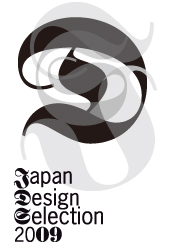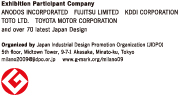Press Preview 21 April h.10:30 AM - 7:00 PM
Special Opening 22 April h.7:00 PM - 12:00 PM
JAPAN DESIGN
KDDI CORPORATION
KDDI Corporation is a leading telecommunications company in Japan. Constituted on October 1, 2000 via the merger of DDI Corporation, KDD Corporation, and IDO Corporation, it provides seamless, integrated global services to its clientele and today, thanks to further mergers, it represents a unified reference point for all telecommunications needs in Japan. It provides mobile telephony solutions under the brand au.
au design project : new forms and experiences in mobile telephony
Around the year 2000, when the folding "clamshell" style of mobile phone was about to become the norm for phone design, we began to hear many complaints that all the phones looked the same, and that people wanted a phone with a more advanced design. The au design project traces its origins to our movement to answer these requests. In May 2001, just as an auto manufacturer introduces beautiful concept cars to the public, we unveiled three concept phones: info.bar, rotary, and wearable. These were our experiments in reconsidering the mobile phone from the perspective of its design, to search for the truly unique and attractive phone that people really wanted and were subconsciously creating in their minds. We received many requests to make these widely-praised prototypes available as actual products, leading to the October 2003 launch of the INFOBAR, which was largely based on the info.bar design.
Since then, the au design project has become a trailblazer, introducing one revolutionary prototype and product after another, and having a tremendous impact on trends in mobile phone design. As proof of our achievements, four of the project's products-INFOBAR, talby, neon, and MEDIA SKIN were chosen for the permanent collection at New York's Museum of Modern Art (MoMA).
WEB site : http://www.au.kddi.com/au_design_project/
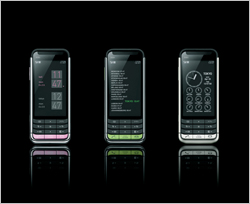
G9 mobile phone
Designer : Ichiro Iwasaki
First model in au(KDDI)'s new iida phone line, developed in collaboration with noted designers, which enliven people's everyday lives with a little design flair. Created by product designer Ichiro Iwasaki.
The designer sought an elegant and comfortable phone, desirable qualities in a modern-day tool. The timeless contours of the sliding body, the stainless steel frame and aluminum keypad, and other touches provide a luxurious look and solid feel to the handset.
Global service in 180 countries worldwide is supported, and the stylish graphical user interface strikes an exceptional balance between looks and readability.
In short, iida G9 demonstrates an elegant finish, lacking in phones to date, and compelling design as a practical tool for modern needs.
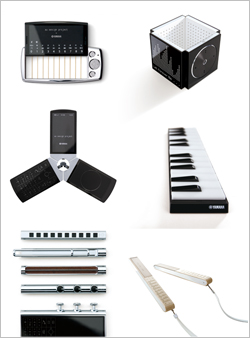
Musical Instruments and Mobile Phones
Design: Yamaha Design Laboratory
Continuing from the "Things that Mobiles have forgotten to take along" exhibition held in the summer of 2007, this project is themed around interactive design. KDDI has collaborated with the Yamaha Product Design Laboratory to propose new user experiences resulting from the fusion of music instruments and mobile phones. In addition to more traditional acoustic instruments, Yamaha has created a multitude of musical instruments such as the Silent series and other electronic instruments that combine new shapes and interactive design without being restricted by preconceived notions. One such instrument is TENORI-ON, which offers a twenty-first century musical interface brought into being through a partnership with media artist Toshio Iwai. Interactive designs conceived to make playing electronic musical instruments both enjoyable and creative have been found to offer abundant inspiration when creating interactive designs for mobile phones. For example, being able to enter text me ssages by ""playing"" a phone like a musical instrument might improve the quality of user communication. There is also the possibility that the ability to perform music on a mobile phone might inspire a more creative lifestyle.
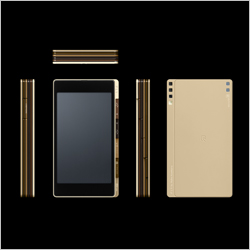
PLY
Design: Hideo Kambara
PLY means "lamination layers." The past and future of mobile phones form "layers" and the PLY concept model was inspired by this idea. The product and interaction design were proposed by Hideo Kambara, designer of the revolutionary, 28-corner Kadokeshi eraser. The layer variations are rich in color, creating a feeling of poetic emotion. The layer concept brings to mind many images, enlarging the freedom of mobile phones and the possibility of other gimmicks and functions on it. At this exhibition, Kambara has created paper craft concept models based on his own color variations and gimmicks.
These works will inspire us to think about the future layers of mobile phones and how we want them to change in years to come.

SOLAR PHONE CONCEPTS
[ voyage ]
Design: MILE
As this year marks the 40th anniversary of the first moon landing, the advent of an international space station will soon usher in a new space era.
The climate of space exploration has shifted from intensified competition among countries to research collaboration for further advanced technologies.
We are now witnessing a fast-approaching future when even those who have not been trained as astronauts can enjoy trips to space.
Our belief is that solar panels will be an icon of this new space era.
The cell phones born out of MILE inspire you to visualize the gigantic artificial entity that moves around above us at this very moment with its huge leaves spread out in gravity-free space. MILE takes you right straight to the new space era.
[ gem ]
Design: MILE
Mother Nature had begun to generate ores deep inside the Earth long before the arrival of mankind.
Ore crystals radiate a sublime shine from deep under the ground, leaving us to wonder if they already knew the sun was there above them.
When mulling over combining photovoltaic generation and cell phones, our design project MILE looked to this complete dark universe under the Earth to bring into use a fraction of the gift of Nature, which has long been nurtured by the Earth. That is because we believe that no one is as close a friend to the Sun as the Earth.
A lump of ore fits snugly in your pocket.
With in the lump of ore, vibrant sunlight is compressed.
Cell phones designed by MILE carry natural energy inside them.
[ SOUP ]
Design: Hironao Tsuboi
According to quantum theory, the term "universal soup" refers to an ultrahigh-temperature, high-density state in which all kinds of substances melted together at the time of Universe Creation, eliminating boundaries among space-times.
Buddhism has a corresponding concept, ku, which means a state in which every event in this world, with no definite substance, intertwines so closely with one another that it leads to unlimited mutual dependency.
The same holds true for cell phones, which feature telephones, email, cameras, music players, the Internet, and our auxiliary charging feature using solar panels.
As opposed to designs or styles extracted from all sorts of popular features and elements of cell phones, we place our aesthetic value for cell phones on a state where a number of these features and elements have become richly concentrated into a "Soup", leaving no trace of their original forms.
This "Soup" extends to boundaries among screen and body, solar panel, speaker, camera, and infrared camera. As we make all possible attempts to dissolve into a "Soup" characteristics, elements and those boundaries that all symbolize cell phones, cell phones designed through "Soup" are graced with universal, pure beauty, suggesting an exceedingly beautiful picture that has never come into the real world except in your imagination.
No mass production is scheduled.

